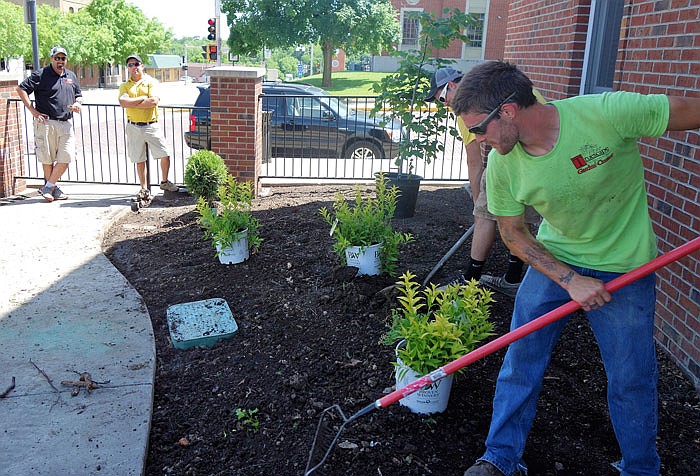Chance Foster spent Wednesday afternoon mulching a new garden at the corner of Market and Fifth streets in Fulton. He and his crew were hastily trying to complete the job before the coming storms.
"This time of year, all our work is rushed," said Foster, co-owner of landscaping company Truescape. "We are trying to get this knocked out before the rain."
For the next week, Mid-Missouri residents can expect rain, with a possibility of severe weather.
"There is a chance through next week of severe weather," said Patrick Walsh, a meteorologist with the National Weather Service in St. Louis. "The term 'severe' weather covers hail, wind and tornados."
That forecast is what pushed Foster and his crew to finish the garden, he said.
"We probably wouldn't have gotten (the landscaping) done today if it weren't for the weather push," said Foster.
Harsh weather patterns experienced by Missouri residents in the spring and summer months are because of an annual weather pattern that causes the change.
"Generally, in the spring you get a shifting of the jet stream which brings in moisture from the Gulf (of Mexico)," said Walsh.
This shift in the jet stream, according to Walsh, is what causes the atmosphere to react to the pressure and moisture changes with severe weather. The atmospheric reaction can result in rain, thunderstorms and tornadoes.
According to Ready.gov, a website designed to educate people about how to respond to disasters, tornadoes are nature's most violent storms. Tornadoes can cause fatalities and devastate a neighborhood in seconds, the website stated.
Peak tornado season is the late spring through summer, and these storms may strike with little to no warning.
"It could be anywhere from minutes to tens of minutes, depending on how far away it is," Walsh said.
Tornadoes often come on the heels of thunderstorms, which in its own rights can be devastating with strong wind, hail and flash flooding. About 10 percent of thunderstorms are classified as severe.
For the next week, according to Walsh, the National Weather Service of St. Louis will be monitoring the weather changes closely.
"We are having uncertainty in the models," Walsh said. "It's going to develop for the next few days, it's going to be looked at on a daily basis."
Be prepared for the worst
According to Ready.gov, people need to be prepared for the worst when dangerous weather approaches.
After an emergency, people may need to survive without help, so they need to plan for food, water and other supplies - enough to last at least 72 hours.
Ready.gov also recommends that families have an emergency communication plan as well as an emergency supply kit.
Another important thing that people can do during severe weather is be aware of what meteorologists are saying, Walsh said.
"Be aware. There are multitudes of outlets for the dissemination of information," said Walsh. "Apps, local TV, and local radio; there are tons of outlets and there are updates constantly."
What's in the kit?
Recommended items to include in a basic emergency supply kit (via Ready.gov):
Water: One gallon of water per person per day for at least three days, for drinking and sanitation.
Food: At least a three-day supply of non-perishable food and a can opener.
Battery-powered or hand-crank radio and a NOAA Weather Radio with tone alert and extra batteries for both.
Flashlight and extra batteries.
First aid kit.
Whistle to signal for help.
Dust mask, to help filter contaminated air and plastic sheeting and duct tape to shelter-in-place.
Moist towelettes, garbage bags and plastic ties for personal sanitation.
Basic tools.

